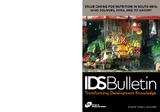Value Chains for Nutrition in South Asia: Who Delivers, How, and to Whom?
| dc.contributor.author | Maestre, Mar | |
| dc.contributor.author | Poole, Nigel | |
| dc.date.accessioned | 2018-01-31T09:48:29Z | |
| dc.date.available | 2018-01-31T09:48:29Z | |
| dc.date.issued | 2018-01-31 | |
| dc.identifier.citation | Maestre, Mar and Poole, Nigel, Eds (2018) Value Chains for Nutrition in South Asia: Who Delivers, How, and to Whom? IDS Bulletin 49.1, Brighton: IDS | en |
| dc.identifier.uri | https://opendocs.ids.ac.uk/opendocs/handle/20.500.12413/13530 | |
| dc.description.abstract | There is currently much talk of the private sector role in nutrition, and whether the state can ‘shape’ the market to deliver better nutritional outcomes. This issue of the IDS Bulletin presents research findings in this area, developed by the consortium of research partners under the Leveraging Agriculture for Nutrition in South Asia (LANSA) programme. The IDS Bulletin aims to analyse existing (or potential) agri-food value chain pathways for delivering nutritious foods from agriculture to vulnerable populations in South Asia. It discusses the role of both public and private actors in making these value chains more effective in achieving sustained increased consumption of nutrient-rich foods. In comparing the different pathways, this set of articles warns against the assumption that increasing the supply of certain products will directly lead to increased consumption. It highlights how, in South Asia, interventions or policies that try to enhance these pathways often struggle because of a mix of supply, distribution, marketing, and consumption challenges. This IDS Bulletin argues that the key to sustainable food systems might be a ‘food sovereignty’ approach. This calls for awareness at all levels of decision-making – public, private and civil society – in the promotion of nutrition-sensitive value chains, emphasising the need for a stronger government role in shaping agri-food value chain pathways. By looking at the limits of what business can and cannot achieve in a given market environment, the IDS Bulletin provides insights to policymakers about how to create an appropriate institutional environment that shapes how these value chains operate for the benefit of nutritionally vulnerable target groups. | en |
| dc.description.sponsorship | Department for International Development (DFID) | en |
| dc.language.iso | en | en |
| dc.publisher | Institute of Development Studies | en |
| dc.relation.ispartofseries | IDS Bulletin;49.1 | |
| dc.rights | This is an Open Access article distributed under the terms of the Creative Commons Attribution 4.0 International licence, which permits unrestricted use, distribution, and reproduction in any medium, provided the original authors and source are credited. http://creativecommons.org/licenses/by/4.0/legalcode | en |
| dc.rights.uri | http://creativecommons.org/licenses/by/4.0/ | en |
| dc.subject | Nutrition | en |
| dc.title | Value Chains for Nutrition in South Asia: Who Delivers, How, and to Whom? | en |
| dc.type | Series paper (IDS) | en |
| dc.rights.holder | Institute of Development Studies | en |
| dc.identifier.team | Business, Markets and the State | en |
| dc.identifier.doi | 10.19088/1968-2018.100 | |
| dcterms.dateAccepted | 2018-01-31 | |
| rioxxterms.funder | Default funder | en |
| rioxxterms.identifier.project | Default project | en |
| rioxxterms.version | VoR | en |
| rioxxterms.funder.project | 9ce4e4dc-26e9-4d78-96e9-15e4dcac0642 | en |
Files in this item
This item appears in the following Collection(s)
Except where otherwise noted, this item's license is described as This is an Open Access article distributed under the terms of the Creative Commons Attribution 4.0 International licence, which permits unrestricted use, distribution, and reproduction in any medium, provided the original authors and source are credited. http://creativecommons.org/licenses/by/4.0/legalcode


